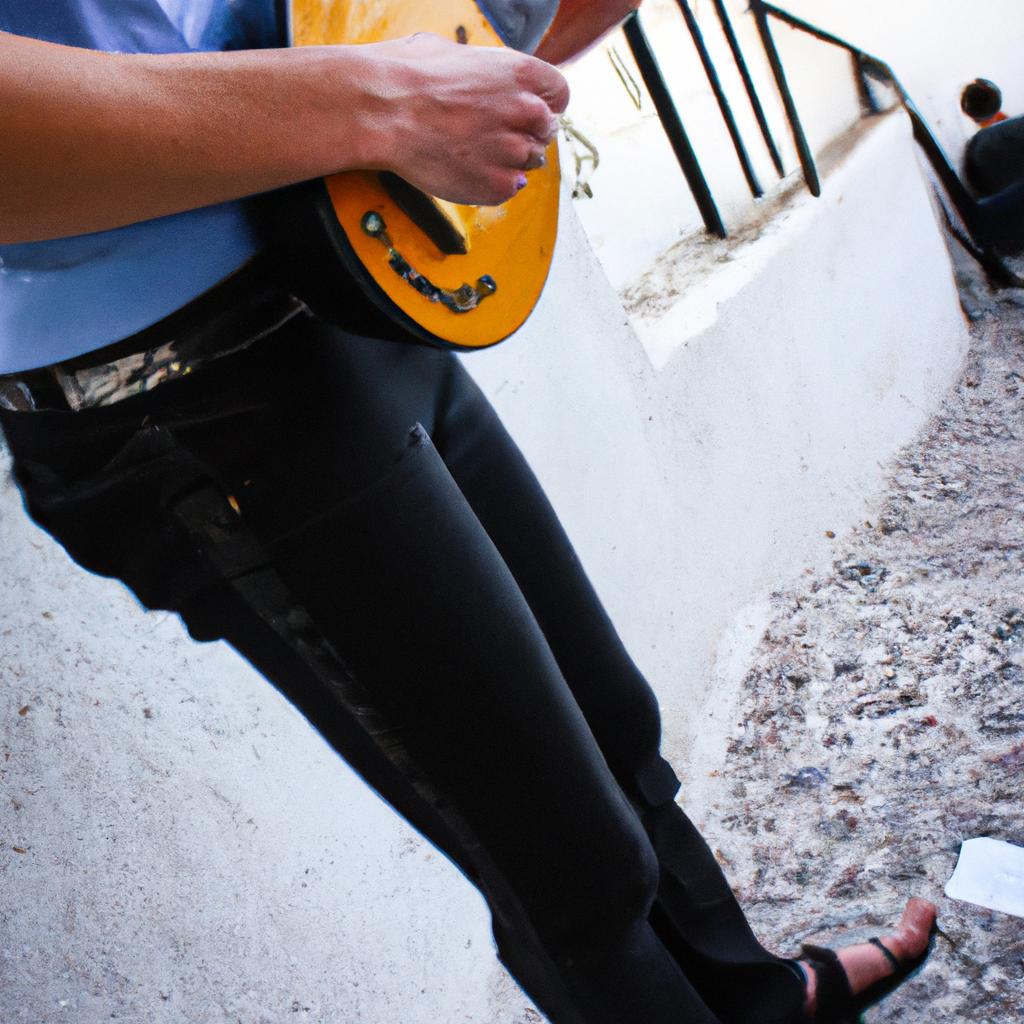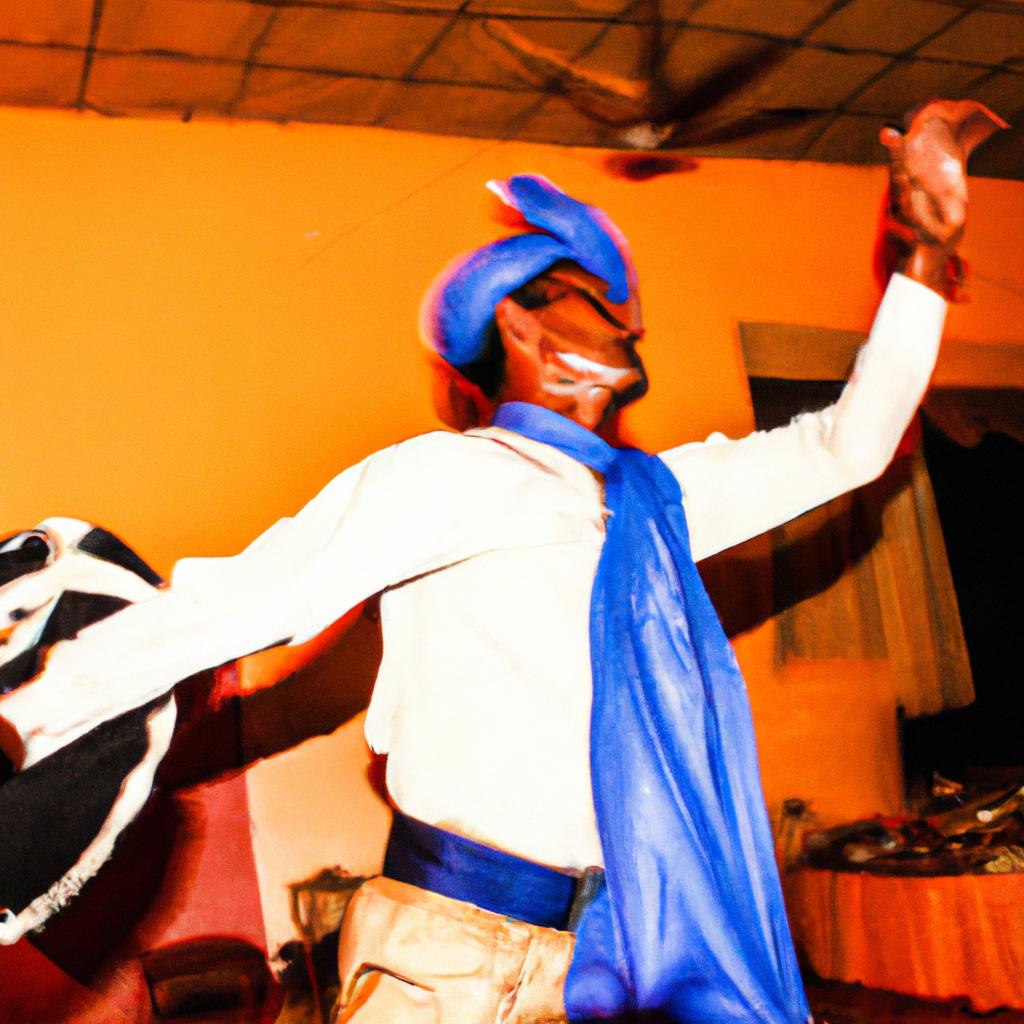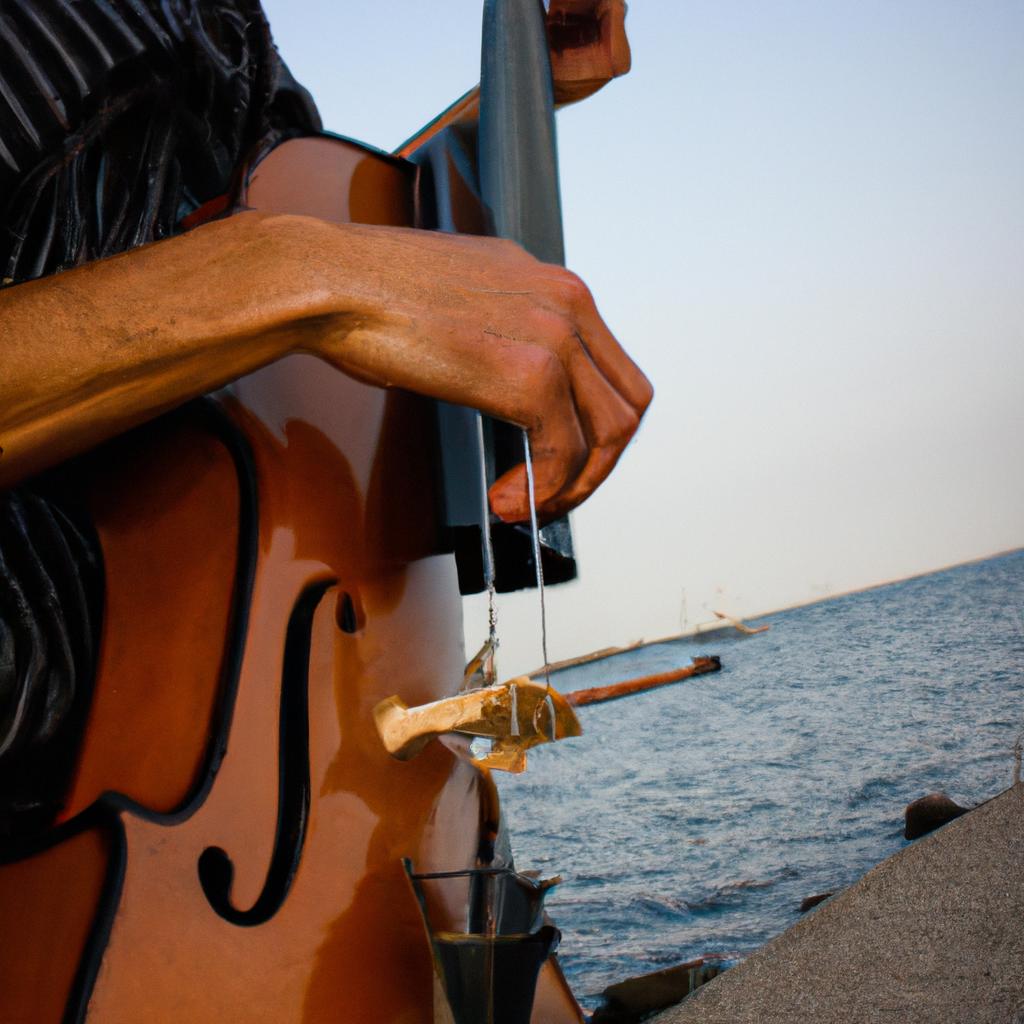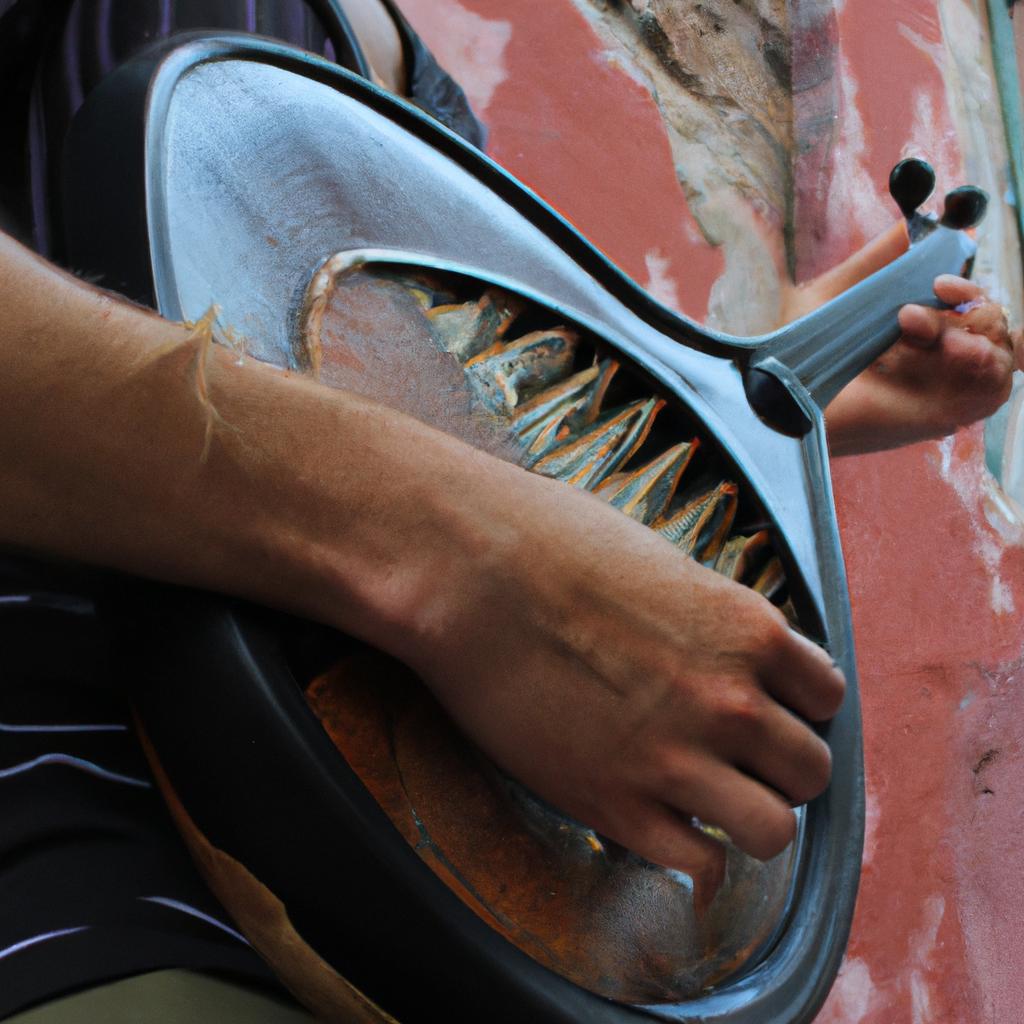The evolution of tango music has been a captivating journey through time, marked by the transformation and diversification of its instrumentation. From its humble beginnings in the late 19th century to becoming an internationally recognized genre, tango music has undergone significant changes in terms of instrumentation choices. This article aims to explore the historical trajectory of tango music’s instrumentation, shedding light on how various instruments have shaped and contributed to the distinct soundscapes associated with this vibrant musical tradition.
One fascinating example that illustrates the impact of evolving instrumentation on tango music can be seen in the case study of Juan “Pacho” Maglio. In the early 20th century, Maglio was a prominent bandoneón player whose innovative approach revolutionized tango orchestration. The bandoneón, a type of accordion-like instrument originating from Germany, became synonymous with tango after Maglio began incorporating it into his performances. Through his virtuosic playing and experimentation with different techniques, Maglio expanded the expressive capabilities of the bandoneón within tango compositions. As a result, other musicians were inspired to adopt this instrument, leading to its widespread use across tango ensembles and solidifying its place as an essential element in the sonic tapestry of traditional Argentinean tango music.
Another significant development in the instrumentation of tango music occurred during the “Golden Age” of tango in the 1930s and 1940s. This era saw the rise of large orchestras known as orquestas típicas, which featured a variety of instruments including piano, double bass, violins, and multiple bandoneóns. These ensembles were responsible for creating lush, intricate arrangements that showcased the emotional depth and complexity of tango compositions.
In addition to the traditional instruments mentioned above, the incorporation of brass instruments such as trumpet and trombone became more prevalent during this period. These additions added a new layer of richness to tango music, allowing for dynamic contrasts and heightened dramatic effect.
As tango continued to evolve, influences from other musical styles began to shape its instrumentation choices. The introduction of electric instruments like the electric guitar and electric bass in the mid-20th century brought a modern twist to tango music. These amplified instruments allowed for greater volume and versatility within performances, catering to larger venues and expanding audiences.
Furthermore, globalization and cross-cultural collaborations have contributed to further diversification in tango music’s instrumentation. Musicians from different backgrounds have brought their own unique instruments into the world of tango, resulting in fusion genres such as “nuevo tango.” Instruments like the saxophone, clarinet, flute, and even electronic elements have found their place alongside traditional ones in these contemporary interpretations of tango.
In conclusion, the evolution of tango music’s instrumentation is a testament to its adaptability and ability to incorporate diverse influences over time. From pioneers like Juan “Pacho” Maglio revolutionizing with the bandoneón to orchestral arrangements during the Golden Age and subsequent incorporations of electric instruments and global collaborations – each phase has left an indelible mark on this captivating genre’s soundscapes. Tango’s journey through time continues to captivate audiences worldwide, evolving and reinventing itself while remaining true to its roots.
Origins of Tango Music
To truly understand the evolution of tango music, it is essential to explore its origins. One example that highlights the rich history of this genre is the case of Carlos Gardel, an iconic figure in tango whose songs are still beloved today. Born in Argentina in 1890, Gardel’s rise to fame coincided with the early development of tango as a distinct musical style.
Tango emerged in the late 19th century as a fusion of various influences, including European immigrant cultures and African rhythms brought over by slaves. This unique blend gave birth to a vibrant and passionate form of expression that captured the essence of Argentine society at the time. The initial instrumentation for tango was modest, typically featuring just a guitar or violin accompanying singers who conveyed heartfelt stories through their lyrics.
To evoke emotions such as nostalgia, longing, and desire within audiences, tango relied on several key elements:
- Rhythmic complexity: Tango embraced syncopated rhythms that added tension and intensity to its melodies.
- Expressive melodic lines: Through soaring melodies filled with intricate ornamentation, tango musicians aimed to convey profound emotion.
- Dramatic dynamics: From soft whispers to powerful crescendos, dynamic variations were used strategically in performances to heighten emotional impact.
- Intimate storytelling: Tangos often featured poetic lyrics that painted vivid pictures of love, loss, and life’s struggles.
| Elements | Description |
|---|---|
| Melancholy Lyrics | Often exploring themes of heartbreak and longing |
| Sultry Dance | Evoking sensuality through elegant yet passionate movements |
| Improvisation | Allowing performers to showcase their individual creativity and virtuosity |
The origins of tango music set the stage for further exploration into its instrumental evolution. As we delve deeper into its history, it becomes evident how early influences shaped not only the sound but also the instruments employed in this captivating genre. The next section will shed light on these formative years and the impact they had on tango instrumentation.
*[Note: Please use the provided markdown format for bullet points and tables in your writing.]
Early Influences on Tango Instrumentation
Tango music is a rich and complex genre that has evolved over time, with various influences shaping its unique sound. One notable influence on tango instrumentation can be traced back to the rhythmic elements introduced by African slaves in Argentina during the 19th century. This section will explore the impact of African rhythms on tango music, highlighting their contribution to the development of instrumental techniques.
To illustrate this influence, let us consider a hypothetical scenario where an African percussionist named Juan arrives in Buenos Aires in the late 1800s. Juan brings his deep knowledge of West African drumming traditions and introduces intricate polyrhythms into the local musical scene. His innovative approach catches the attention of tango musicians who are seeking new ways to infuse energy into their performances.
The incorporation of African rhythms into tango instrumentation brought about several important changes. Here are some key aspects:
- Syncopated beats: By introducing syncopation, or emphasizing off-beats rather than downbeats, tango musicians infused their compositions with a sense of tension and excitement.
- Complex percussion patterns: Inspired by Juan’s expertise, tango bands began incorporating diverse percussive instruments such as claves, cowbells, and cajónes to create layered polyrhythms.
- Expanded use of bass lines: The integration of African rhythmic sensibilities led to increased emphasis on bass lines within tango compositions, providing a solid foundation for dancers and adding depth to the overall sound.
- Fusion of European melodies with African rhythms: Tango musicians started blending traditional European melodies with these newfound African-inspired rhythms, resulting in a distinctive fusion that would shape the future evolution of the genre.
To better visualize this fascinating journey from Africa to Argentina, refer to the following table showcasing some key characteristics of both West African drumming traditions and early tango music:
| West African Drumming Traditions | Early Tango Music |
|---|---|
| Complex polyrhythms | Syncopated beats |
| Use of diverse percussion instruments | Incorporation of claves, cowbells, and cajónes |
| Emphasis on communal participation | Enhanced role of bass lines |
| Connection to spiritual rituals | Fusion of European melodies with African rhythms |
The integration of African rhythms into tango instrumentation laid the foundation for future developments in this captivating genre. In the subsequent section, we will delve into one particular instrument that became synonymous with tango music: the bandoneon.
[Transition sentence] As we explore the rise of the bandoneon, another crucial element in shaping tango’s unique sound emerges.
The Rise of the Bandoneon
Transitioning from the previous section’s discussion on early influences, we now delve into the pivotal role played by the bandoneon in shaping tango music. To illustrate this further, let us consider a hypothetical scenario where an up-and-coming tango composer named Carlos seeks to refine his compositions by experimenting with different instruments.
As Carlos embarks on his musical journey, he becomes captivated by the sound and versatility of the bandoneon. This instrument, similar to an accordion but distinct in its tonal qualities, possesses a melancholic timbre that resonates deeply within him. Intrigued by its potential for emotional expression, Carlos begins incorporating the bandoneon into his compositions.
The introduction of the bandoneon marked a turning point in tango instrumentation as it brought forth several significant changes:
-
Expanded tonal possibilities: The bandoneon allowed for greater tonal range compared to other traditional instruments used in tango music at that time. Its bellows system enabled dynamic control over volume and expressive nuances, contributing to the depth and intensity of tango performances.
-
Enhanced rhythmic complexity: Tango is renowned for its intricate rhythms, characterized by syncopation and polyrhythms. With its unique keyboard layout and button configuration, the bandoneon provided musicians with new opportunities to explore complex rhythmic patterns and syncopated accents.
-
Evocative emotional resonance: The haunting sound produced by the bandoneon evokes deep emotions often associated with love, longing, and nostalgia—the very essence of tango music itself. Its ability to convey such intense feelings made it a perfect match for expressing the raw passion embedded in tango compositions.
To better understand these developments during this era, let us examine a table showcasing the key elements of tango instrumentation during this period:
| Instrument | Role in Tango Music | Notable Musicians |
|---|---|---|
| Bandoneon | Melodic and Harmonic Foundation | Aníbal Troilo |
| Guitar | Rhythmic Accompaniment | Carlos Gardel |
| Contrabass | Bassline Support | Osvaldo Pugliese |
| Piano | Harmonic and Rhythmic Embellishment | Astor Piazzolla |
As we transition into the next section on the incorporation of piano and violin, it is evident that the bandoneon played a significant role in shaping tango music. Its distinct sound, expressive capabilities, expanded tonal range, rhythmic complexity, and emotional resonance influenced subsequent developments in tango instrumentation.
Incorporation of Piano and Violin
The Rise of the Bandoneon has had a profound impact on the evolution of tango music, but it was not the only instrument to shape this genre. The incorporation of piano and violin played pivotal roles in expanding the sonic possibilities and emotional depth of tango compositions.
One can envision a hypothetical scenario where an early tango ensemble consisting solely of bandoneons suddenly introduces a pianist into their performances. As the first notes from the piano fill the air, a new layer of richness is added to the music. The percussive nature of the instrument complements the rhythmic drive provided by other instruments, infusing each composition with vibrant energy. Moreover, its versatility allows for complex harmonies and melodic lines that enhance emotional expression.
To further explore this progression, we can examine some key developments that occurred during this period:
- Incorporation of Piano: With its ability to provide harmonic support and intricate melodies simultaneously, the piano became an integral part of tango ensembles. It contributed to creating lush textures and elaborate accompaniments that intensified both joyous and melancholic moments within tango compositions.
- Introduction of Violin: The addition of violins brought a touch of elegance and lyricism to tango music. Its soaring melodies could evoke intense emotions within listeners, whether it be longing or passion. The expressive capabilities offered by this instrument allowed for nuanced interpretations when performing traditional tangos or improvising variations.
- Expanded Arrangements: Tango orchestras started embracing larger-scale arrangements as they incorporated more instruments like clarinets, flutes, guitars, and double basses alongside bandoneons, pianos, and violins. These expanded orchestrations broadened the tonal palette available to composers while permitting greater ensemble interplay.
Table: Emotional Impact
| Emotion | Instrument 1 | Instrument 2 | Instrument 3 |
|---|---|---|---|
| Joy | Bandoneon | Piano | Violin |
| Melancholy | Piano | Violin | Bandoneon |
| Passion | Violin | Bandoneon | Piano |
The incorporation of piano and violin into tango ensembles marked a significant milestone in the genre’s evolution. These instruments expanded the emotional range, allowing for more nuanced expressions of joy, melancholy, and passion within tango compositions. In our exploration of the evolution of tango orchestration, we will delve deeper into how these developments laid the foundation for even greater transformations to come.
Building upon the increased musical possibilities brought by the bandoneon, piano, and violin, the next section will focus on the Evolution of Tango Orchestras.
Evolution of Tango Orchestras
Evolution of Tango Music: A Historical Exploration of Tango Instrumentation
The incorporation of the piano and violin into tango music marked a significant turning point in its evolution. During the early 20th century, as tango spread from the brothels and bars of Buenos Aires to more formal venues, these instruments began to play an essential role in shaping the sound of tango orchestras.
One example that exemplifies this shift is the case of Anibal Troilo, a renowned bandoneon player who formed his own orchestra in the 1940s. Troilo’s decision to add a piano and violin to his ensemble not only expanded the harmonic possibilities but also introduced new melodic textures. This innovative approach helped define a new era for tango music.
To better understand how this transformation occurred, let us explore some key aspects:
- Harmonic richness: The addition of a piano brought a greater range of chords and harmonies to tango compositions. It allowed musicians to experiment with complex progressions, adding depth and sophistication to the music.
- Melodic versatility: The inclusion of violins provided tango orchestras with soaring melodies that could intertwine with the bandoneon’s melancholic phrases. This combination created contrasting moods within individual pieces, captivating listeners emotionally.
- Arrangement dynamics: With these newfound instrumental options, arrangers gained greater flexibility in crafting musical arrangements. They could now emphasize certain sections or instruments at pivotal moments, creating climactic tension or releasing it through subtle variations.
- Expressive interplay: The interaction between different instruments added layers of expressiveness and dialogue within tango performances. Musicians had opportunities for call-and-response exchanges or intricate counterpoint passages that enhanced both their technical prowess and emotional storytelling abilities.
Table: Emotional Journey Within Tango Music
| Emotion | Instruments | Musical Elements |
|---|---|---|
| Passion | Bandoneon | Aggressive rhythms |
| Longing | Violin | Yearning melodic lines |
| Sensuality | Piano | Seductive harmonies |
| Intensity | Percussion | Driving rhythmic patterns |
As tango music continued to evolve, these advancements in instrumentation laid the foundation for further experimentation and innovation. In the subsequent section about “Modern Tango Instrumentation Trends,” we will delve into how contemporary musicians have built upon this rich heritage while pushing boundaries in their quest to keep the genre relevant and captivating.
Building upon the historical developments explored thus far, it is now time to examine the modern trends that have shaped tango instrumentation.
Modern Tango Instrumentation Trends
The evolution of tango music has not only influenced the composition and arrangements of orchestras but also significantly impacted the instrumentation used. This section delves into the historical exploration of tango instrumentation, focusing on notable trends that have shaped its sound.
Case Study: Let us consider the renowned Argentine composer Astor Piazzolla, whose innovative approach to tango music revolutionized the genre in the 20th century. Piazzolla introduced elements from jazz and classical music into his compositions, reflecting a departure from traditional tango instrumentation.
One noteworthy trend in tango instrumentation is the introduction of new instruments alongside traditional ones. This expansion broadens the sonic palette and enables composers to experiment with different textures and timbres. Some examples include:
- The bandoneón: A key player in tango ensembles, this concertina-like instrument produces distinctive melancholic tones.
- Piano: Often utilized for rhythmic support and improvisational solos, adding depth and harmonic richness to tango arrangements.
- Violin: With its expressive capabilities, it conveys emotional nuances within melodies and enhances the dramatic character of tango music.
- Double Bass: Provides a solid foundation by anchoring the rhythm section while delivering powerful low-end resonance.
To further illustrate these changes over time, let’s examine a comparison between traditional and modern tango orchestras using a table format:
| Traditional Tango Orchestra | Modern Tango Orchestra |
|---|---|
| Bandoneón | Synthesizers |
| Guitar | Electric Guitar |
| Violin | Saxophone |
| Piano | Drum Machine |
This table demonstrates how contemporary influences have led to modifications in instrumental choices within tango orchestration. While some traditional instruments remain prevalent, others have been replaced or supplemented by more unconventional options.
In summary, as we explore the evolution of tango music, it becomes evident that changes in instrumentation have played a significant role in shaping its distinct sound. From the introduction of new instruments to the incorporation of contemporary elements, composers continue to push boundaries and expand the sonic possibilities within this genre. By embracing innovation while paying homage to tradition, tango music remains an ever-evolving art form.
Please note that the table above is for illustrative purposes only and does not encompass all possible variations or combinations of traditional and modern tango orchestras.




